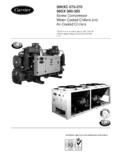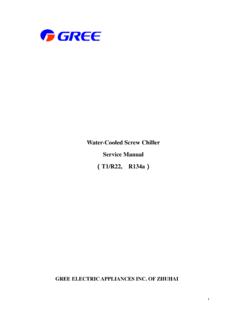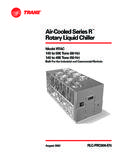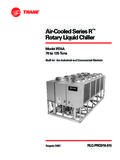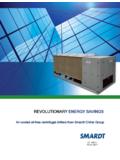Transcription of 30HXC 075-370 30GX 080-350 Screw Compressor Water …
1 Installation, operation and maintenance instructions30 HXC 075-37030GX 080-350 Screw CompressorWater- cooled Chillers andAir- cooled Chillers30 HXC Nominal cooling capacity 268-1290 kW30GX Nominal cooling capacity 262-1160 kW50 Hz2 The cover photograph is for illustrative purposes onlyand is not part of any offer for sale or of contentsINTRODUCTION .. 4 SAFETY CONSIDERATIONS .. 4 DIMENSIONS, CLEARANCES,WEIGHT DISTRIBUTION .. 530 HXC 075-185 .. 530 HXC 215-280 .. 630 HXC 300-370 .. 730GX 080-160 .. 830GX 175 .. 930GX 205-265.
2 1030GX 280-350 .. 11 MAIN COMPONENT LOCATION .. 1230 HXC 075-185 .. 1230 HXC 215-280 .. 13 PHYSICAL DATA .. 1430 HXC .. 14 ELECTRICAL DATA .. 1530 HXC .. 15 Compressor .. 15 PHYSICAL DATA .. 1630GX .. 16 ELECTRICAL DATA .. 1730GX .. 17 Compressor .. 17 APPLICATION DATA .. 18 Unit operating range .. 18 Minimum chilled Water flow .. 18 Maximum chilled Water flow .. 18 Cooler flow rate (l/s) .. 19 Condenser flow rate (l/s) .. 19 Variable flow evaporator .. 19 System minimum Water volume .. 19 Flow controllers .. 20 INSTALLATION.
3 20 Check equipment received .. 20 Moving and siting the unit .. 20 LIFTING INSTRUCTIONS .. 2130 HXC 075-185 .. 2130 HXC 215-280 .. 2230 HXC 300-370 .. 2330GX 080-160 .. 2430GX 175 .. 2430GX 205-265 .. 2530GX 280-350 .. 25 PIPING CONNECTIONS .. 26 Operating precautions .. 26 Cooler and condenser connections .. 26 Pipe connections .. 26 Freeze protection .. 26 ELECTRICAL CHARACTERISTICS .. 27 Power supply .. 27 FIELD POWER SUPPLY .. 2830 HXC 075-185 .. 2830 HXC 215-280 .. 2930 HXC 300-370 .. 3030GX 080-160 .. 3130GX 175 .. 3230GX 205-265.
4 3330GX 280-350 .. 34 MAJOR SYSTEM COMPONENTSAND OPERATION DATA .. 35 Geared twin Screw Compressor .. 35 Cooler .. 35 Condenser and oil separator (30 HXC) .. 35 Oil separator (30GX) .. 35 Electronic Expansion Device (EXD) .. 35 Economizer .. 35 Oil pumps .. 36 Motor cooling valves .. 36 Back pressure valve (GX only) .. 36 Sensors .. 36 Thermistors .. 36 Pressure transducers .. 36 Control components .. 37 CONTROL OPERATION .. 39 Keypad and display module usage (HSIO II) .. 39 Functions and subfunctions .. 39 Accessing functions and subfunctions.
5 40 Status function .. 41 Test function and subfunctions .. 43 Schedule function .. 44 Service function .. 44 History function and subfunctions .. 46 Setpoint function .. 47 Head pressure control .. 48 PRE-START-UP PROCEDURE .. 50 System Check .. 50 Start-up and operation .. 50 Actual Start-up .. 50 Operating Sequence .. 50 TROUBLESHOOTING .. 51 Checking display codes .. 51 Unit shutoff .. 51 Complete unit stoppage .. 51 Single Circuit Stoppage .. 51 Restart procedure .. 51 Alarms and alert .. 51 Alarms and alerts codes table.
6 52 Low oil pressure alert criteria and setpoints (Alert 40 to 43) .. 56 MAINTENANCE .. 57 Refrigerant Charging - Adding Charge .. 57 Oil Charging - Low oil recharging .. 58 Service replacement Compressor .. 59 EXV Troubleshooting Procedure .. 59 START-UP CHECKLIST FOR 30 HXC/30GX .. 60 Preliminary information .. 60 Preliminary equipment check .. 60 Unit start-up .. 614 INTRODUCTIONP rior to initial start-up of the 30 HXC and 30GX unit, thoseinvolved in the start-up, operation, and maintenance should bethoroughly familiar with these instructions and other necessaryjob data.
7 This book provides an overview so that you may becomefamiliar with the control system before performing start-upprocedures. Procedures in this manual are arranged in the sequencerequired for proper machine start-up and CONSIDERATIONS30 HXC and 30GX liquid chillers are designed to provide safeand reliable service when operated within design operating this equipment, use good judgment and safetyprecautions to avoid damage to equipment and property or injuryto sure you understand and follow the procedures and safetyprecautions contained in the machine instructions as well as thoselisted in this NOT VENT refrigerant relief valves within a building.
8 Outletfrom relief valve must be vented outdoors. The accumulation ofrefrigerant in an enclosed space can displace oxygen and adequate ventilation, especially for enclosed and lowoverhead spaces. Inhalation of high concentrations of vapor isharmful and may cause heart irregularities, unconsciousness,or death. Misuse can be fatal. Vapor is heavier than air andreduces the amount of oxygen available for breathing. Productcauses eye and skin irritation. Decomposition products NOT USE OXYGEN to purge lines or to pressurize amachine for any purpose.
9 Oxygen gas reacts violently with oil,grease, and other common EXCEED specified test pressures, VERIFY theallowable test pressure by checking the instruction literatureand the design pressures on the equipment NOT USE air for leak testing. Use only refrigerant or NOT VALVE OFF any safety SURE that all pressure relief devices are properly installedbefore operating any NOT WELD OR FLAMECUT any refrigerant line or vesseluntil all refrigerant (liquid and vapor) has been removed fromchiller. Traces of vapor should be displaced with dry air nitrogenand the work area should be well ventilated.
10 Refrigerant incontact with an open flame produces toxic NOT work on high-voltage equipment unless you are aqualified NOT WORK ON electrical components, including controlpanels, switches, relays etc, until you are sure ALL POWER ISOFF and residual voltage can leak from capacitors or solidstate OPEN AND TAG electrical circuits during servicing. IFWORK IS INTERRUPTED, confirm that all circuits are de-energized before resuming NOT siphon SPILLING liquid refrigerant on skin or getting it intothe eyes.
